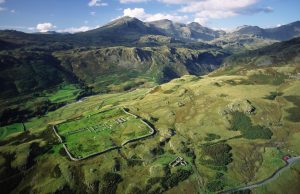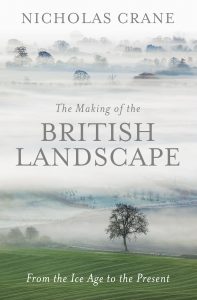
According to the Daily Mail, Nicholas Crane, co-presenter of Coast and prize-winning author, is a ‘national treasure’. He modestly assures me that they haven’t always been so complimentary towards him.
I meet Nick to talk about his masterwork of a book: The Making of the British Landscape. It is the story of how humans have shaped our habitat and how it has shaped us in the course of 12 millennia. It is a story of immigration, global warming, destruction and rebuilding which we would do well to heed today.
The morning we meet is white with frost and Nick was just back from the top of Primrose Hill, which is how he starts his day. “Standing there in the frost it isn’t difficult to imagine going back 12 millennia. The view is topographically unchanged in terms of hill and valley. To see how it looked 12,000 years ago, replace the modern, artificial landscape with tundra. By 10,000 years ago, it would have been a tree filled valley. By 5,000 years ago the woodland was mixed with clearings and spirals of wood smoke”.
The hill itself is natural and with neighbouring Barrow Hill has been a vantage point for thousands of years. Although ‘barrow’ is normally taken as a reference to a burial mound, it’s also the Old English word for a place by a wood or grove. The people who first permanently settled these hillslopes chose well. They are south-facing slopes, so warm, sunny and a pleasant place to farm. Barrow Hill has been decapitated by the reservoir and its slopes filled with blocks of flats. The battle between town and country is central to Britain’s narrative and so is the challenge to provide affordable housing in the right places.
Nick moved to Primrose Hill in 1991, but he already had a connection here. In the 1880s and 1890s, his great-grandparents lived in Belsize Park. When she was a girl, Nick’s grandmother walked from Belsize Avenue to St Paul’s Girls school in Hammersmith. Her route took her over Primrose Hill where she’d pass Percy Dearmer (the vicar of St Mary’s who produced The English Hymnal with Ralph Vaughan Williams) tossing back his scarf in the wind. “There was a certain amount of homing instinct in moving here”.
Nick first bought a house in Eglon Mews, but after he married Annabel Huxley and had two of their three children, they moved to Berkley Road. “There was a guy who did odd jobs in Primrose Hill at the time who had a milk float, so I hired it for the day and moved everything over.” When he’d finished the move, Nick realised he’d probably never have the chance to drive a milk float again, so he took it on a tour of Primrose Hill.
The Making of the British Landscape is peppered with dramatic climate changes which sculpted the geography of our island. Britain was connected to mainland Europe 12,000 years ago. Around 9700 BC temperatures rose, the ice melted and the tundra transformed into woodland. People became ‘woodland dwellers’ making tools from stone and hunting deer and boar.
Around 6700 BC a ‘Little Ice Age’ hit Britain and bleak centuries of cold, stormy winters resulted. Trees died, sea levels flooded the rivers, the growing season was shortened and our landscape changed again.

To highlight how globally interconnected we are, in around 6,200 BC a vast lake in North America burst its banks and flooded the North Atlantic with chilled water. Temperatures in this part of Europe fell by 5°, sea levels rose and ecosystems shut down. “A global chilling aftershock thousands of miles away had changed the shape and nature of Britain in a matter of months.”
One autumn day around 200 years later a tremor in the earth’s crust released a huge tract of seabed debris which caused a giant tsunami to cascade over Britain, starting in the Shetlands and crashing on down through the country. People living by the coast in northern Britain would have been met with a 20-metre wall of water which swept away entire communities in its wake.
The ancient plain of Doggerland, which connected Britain to the rest of Europe, faced rising sea levels and its dwellers moved west to safety. The plain had become little more than a precarious bridge connecting Britain to Europe. As the temperatures continued to rise, the North Sea and the Channel finally met, the isthmus was ruptured, and Britain, for the first time in its history (but not the last), was cut adrift from the rest of Europe.
All of this is scary stuff and I ask Nick what he thinks the future might hold for us in terms of global warming. “Collectively, we’re burying our heads in the sand and need to address climate change. It can be abrupt. We now have warming oceans, melting ice, rising sea-levels. Weather patterns are tending to become more extreme.”
Landscapes, our human habitat, will be bound to change, too. Nick believes we need to approach climate change in three ways: urgently reduce emissions, and think about adaptive, resilient communities and low carbon economies.
Climate had gone part way to creating the landscape of Britain, and the growing population followed suit. Further immigrants arrived by boat. These were the ‘house people’ who built rectangular houses and began to leave traces on the landscape.
When the Romans invaded Britain in AD 43, Emperor Claudius brought with him ‘an army of psychopathic builders’ and Britain developed 24 major towns. The Normans created another urban boom, followed by another freeze, rains, famines and the Black Death. Villages were left abandoned and farming was neglected. Fast forward in time and canals, bridges and docks were constructed.

By 1800 London was the largest city there had ever been in the world. In the previous 60 years the ancient hedgerows and field paths bordering Oxford Street had been developed. Between Primrose Hill and Kilburn was open country. South of Primrose Hill was a valuable area of farmland, Marylebone Park. In 1811 the lease for the farm ended and architect-turned-planner John Nash won a competition for how best to develop the land. His scheme was to create a park with trees, a lake and grand terraces. The northern edge was to have a new canal. To prevent undesirables entering the park, Nash minimised the number of bridges over the canal.
The development of Regent’s Park brought this part of London into contact with Regent’s Street and the West End. Primrose Hill became more mapped and part of the greater conurbation. Most significant for our neighbourhood was the coming of the railway, which stamped the Industrial Revolution on our landscape. Tunnels, bridges and embankments were built to overcome the ‘unhelpful undulations of Britain’s landscape’.
After the Second World War, 14 million tons of debris had to be cleared. Much of it was used for rebuilding, but the unusable waste was taken to dumps, including the northern part of Regent’s Park (where it appears in dry summers) and the Cumberland Basin on the canal, which is now the zoo cark park.
Nick finds it hard to walk round London without being moved by the landscape. “It’s an unbelievably rich landscape, with the capacity to help you time travel to any period. It all has stories to tell.”
The reason why Nick wrote the book was to create a fresh narrative of Britain and its habitat, one not told through events of kings and queens and battles. “Modern politics is based on historical events, rather than geographical evolution. But that only goes back 2,000 years. You struggle to find any narrative which fills in the missing 10,000 years. The only story which makes any sense is the one which starts before humans came and then the influx of people from all parts. Cultural diversity is fascinating and part of living in one of the world’s most interesting islands.”
Given that Nick is a total expert on Britain, having travelled to every corner for his books and the programmes Coast and Town, I ask where he would choose to live in Britain, if he had complete choice? The answer: “Here in Primrose Hill. Nowhere else comes remotely close. I’ve never lived in such a warm community.”
Article by Maggie Chambers
Buy The Making of the British Landscape from
Primrose Hill books | Waterstones | Amazon




